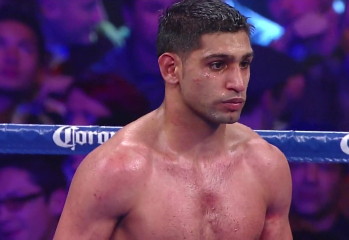 By Bassenco: Amir Khan’s latest defense against charges of a glass jaw has been to move up in weight. He has asserted that this move will be the cure for his reputed “glass jaw.”
By Bassenco: Amir Khan’s latest defense against charges of a glass jaw has been to move up in weight. He has asserted that this move will be the cure for his reputed “glass jaw.”
The reputation for having a glass jaw has to be explored, first, by understanding how a punch off the tip of the chin can knock out a fighter. Medical experts who treat boxers say that it’s the speed of head and neck rotation, especially from a punch that hits unseen, that knocks out a fighter with a glass chin. The extent that nerve tissue in the brain is distorted, or stretched, by the swift rotation, determines the efficacy of the knockout punch.
Granite jawed fighters can take direct hits on the jaw and chin without wavering. Glancing blows that turn the chin and snap the head around also leave them unfazed. To an extent, this invulnerabiity is a gift from God: these men are just impervious to the effects of punches that would drop most of the rest of us.
Many of us watched the Jones-Lebedev fight in which Lebedev did pepper Gulliermo Jones with some heavy bombs in rounds six and seven. Jones, older, awkward, and out of shape (or so it appeared), took them all and came back hitting. Nobody could explain how this old guy could take the punishment, but he did.
Fighters like Evander Holyfied, who researched every nuance of boxing, minimized the effect of punches to the chin and jaw by building up massive trapezus and neck muscles. Others have theorized that weak legs make a weak jaw. In the sense of the physics of receiving a punch, there is a certain merit to the idea of legs as a necessary part of shock abosrption. The higher a boxer stands, the less effective he is at making his entire body a shock absorber. His neck and head become more isolated and thus more susceptible to that devastating shock wave from a punch to (or off of) the chin. It may not be that the legs are weak; more that they are not being put to good use to act as shock absorbers.
If a fighter could adopt a slightly lower stance, with a muscular neck resting in a muscular “saddle” of trapezus and shoulder muscles, and the upper body resting in a muscular cradle of the upper legs, the fighter’s body would be at its best in terms of being a single shock absorber. Regrettably, this is not nearly enough. Very muscular fighters who have learned to rest in a lower stance on strong legs can still suffer from the glass jaw effect.
Other fighters have practiced slipping punches and reacting to punches by repetition. They try to train muscle memory by repeatedly reacting to light punches and taps with better muscle reaction than a radical head spin. They learn to roll with the punch or “sit back” in their stances, falling back on the cushion of their legs, with straight, relaxed backs when they are hit. They incorporate ki/chi training into their daily regimen. These strategies have never been proved all that effective in fighters most prone to knockouts.
Better muscle development, better stance, better training to receive a punch, can help a glass jawed fighter to a limited extent. Let’s face it: any fighter can improve with a better body, better stance, and better training. But in the end, nobody has ever made a glass jawed fighter into a granite jawed fighter.
So, what about Amir Khan’s predicament? Well, Khan can improve by the three B’s above, but they cannot turn him into Superman. He can also fight with his chin tucked and his hands up: two of the best protections for a fighter’s chin. Strategies to get the other guy to expose his face and chin would be better yet. A fighter’s best weapon, after all, is his brain.
Comments are closed.